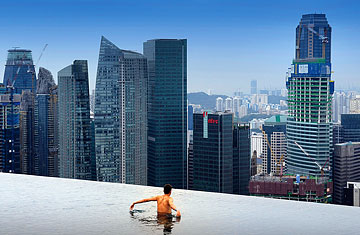
Bay watch The view from the rooftop pool of the Marina Bay Sands is stunning
Where the mouth of the Singapore river hits the sea, the Lion City's historic birthplace, a brand new multibillion-dollar city-within-a-city has arisen. Called Marina Bay, it is a commercial, residential, dining and entertainment district girdled by a vast freshwater reservoir, lined by office towers and high-end residences, and boasting an art-filled, Venetian-style piazza swathed in cooling, machine-emitted mist.
Marina Bay's glittering facade reflects a local economy that will grow 13% to 15% this year by official estimates, and not surprisingly, most of the development's diversions are designed for those who have benefited from the boom. Want to enjoy its restaurants, shops, hotels, resort and casino? Then be prepared to spend.
Start your exploration of the new district in the Fullerton Bay Hotel, fullertonbayhotel.com. Named after Robert Fullerton, a former colonial governor, this boutique property stands on stilts, allowing the bay's chocolate-colored waves to lap beneath its low-lying rooms. Located on the spot where the largely seaborne immigrants to Singapore originally landed, bay-view rooms go from roughly $440 a night. If that's too much, you can take in the same vistas for the price of a drink at Lantern, the hotel's rooftop bar.
Fortified by a tipple, proceed on foot around Marina Bay's sickle-shaped piazza to the City Gallery, marina-bay.sg. This free mini-museum tells the story of Marina Bay from its inception — a tale that reflects the pace of Singapore's own growth. Parts of Marina Bay were dredged as far back as the 1970s, and the first land parcel was sold nine years ago. But it wasn't until Singapore's property market began to boom in 2004 — triggered by a swelling population — that construction at Marina Bay began to really accelerate.
A 10-minute walk away from the glass-walled City Gallery is the giant Marina Bay Sands gambling resort, marinabaysands.com. The resort includes Singapore's largest hotel, one of the biggest convention centers in Asia, a mall and seemingly countless gourmet restaurants, among them Waku Ghin, tel: (65) 6688 8507, which is run by celebrity chef Tetsuya Wakuda, and upscale Mediterranean eatery Santi, tel: (65) 6688 8501, set up by renowned Catalan chef Santi Santamaria. There are also architectural flourishes like a canoe-shaped "skybridge" that knits together the Marina Bay Sands' three soaring towers. The view from the top is heady — particularly if you're ensconced in one of the Straits Suites, which are at least 50 floors up. These bolt-holes for millionaires are decorated in the sort of style an Ottoman sultan would favor, and are scattered with wide-screen televisions and sunken marble tubs. Meant for high rollers who place vast bets at the casino's baccarat tables, they go for more than $5,000 a night.
Marina Bay is itself something of a gamble, of course. As with nearly every instance of urban engineering of this magnitude, be it London's Canary Wharf or Shanghai's Pudong, Marina Bay's commercial success or failure will be decided years, maybe even decades, from today. But right now the cost-accounting perspective is hardly front and center. Instead, Marina Bay is all about providing entertainment. After nearly half a century of relentlessly pursuing affluence, and now attaining it, Singaporeans are ready for some fun.
